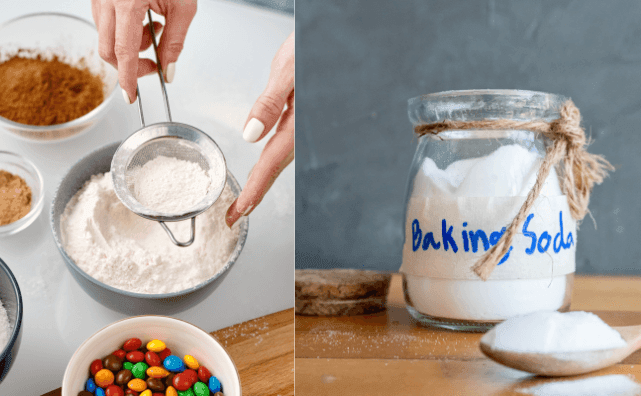
Baking Soda vs. Baking Powder: Understanding the Difference
Baking soda and baking powder are staples in baking, yet they often confuse even experienced bakers. While both are leavening agents used to create fluffy, airy baked goods, their composition and uses differ significantly. This detailed comparison will help you understand when and why to use each, ensuring your baked creations turn out perfect every time.
What is Baking Soda?
Baking soda, or sodium bicarbonate, is a single chemical compound. It’s an alkaline substance that reacts with acids to produce carbon dioxide gas. This reaction is immediate and powerful, making it an effective leavening agent for quick breads, cookies, and other baked goods.
How Baking Soda Works
When combined with acidic ingredients such as buttermilk, vinegar, or lemon juice, baking soda undergoes a chemical reaction, producing carbon dioxide bubbles. These bubbles expand during baking, causing the dough or batter to rise.
When to Use Baking Soda
Baking soda is ideal for recipes that include acidic components. Common examples include:
- Chocolate chip cookies (often containing brown sugar or chocolate, which are mildly acidic).
- Pancakes (with buttermilk or yogurt).
- Banana bread (using mashed bananas as the acidic element).
Too much baking soda can result in a soapy or metallic taste. It’s important to measure carefully and balance it with an appropriate amount of acid.
What is Baking Powder?
Baking powder is a complete leavening agent that contains both an acid (usually cream of tartar) and a base (baking soda), along with a filler like cornstarch to prevent clumping. It comes in two types: single-acting and double-acting.
How Baking Powder Works
- Single-acting baking powder: Reacts once when mixed with liquid.
- Double-acting baking powder: Reacts twice, once when mixed with liquid and again when exposed to heat. This type is more commonly used and provides more consistent results.
When to Use Baking Powder
Baking powder is perfect for recipes that do not contain acidic ingredients. It’s often used in:
- Cakes (like sponge cakes or vanilla cakes).
- Muffins.
- Biscuits.
Double-acting baking powder is versatile and forgiving, allowing batters to sit for a short time before baking without losing their leavening power.
Key Differences Between Baking Soda and Baking Powder
|
Feature |
Baking Soda |
Baking Powder |
|
Composition |
Pure sodium bicarbonate |
Sodium bicarbonate, acid, and filler |
|
Reaction |
Requires an acid to react |
Reacts on its own (already contains acid) |
|
Taste Impact |
Can taste metallic if overused |
Neutral taste |
|
Use Case |
Recipes with acidic ingredients |
Recipes without acidic ingredients |
Tips for Substitution
If you’re out of one, you can substitute, but it’s not a one-to-one swap:
- Replacing baking soda with baking powder: Use about 3 times the amount of baking powder as baking soda. Note that this may slightly alter the taste and texture.
- Replacing baking powder with baking soda: Add an acid to the recipe. For example, 1 teaspoon of baking powder can be substituted with 1/4 teaspoon of baking soda + 1/2 teaspoon of lemon juice or vinegar.
Common Mistakes to Avoid
- Using the wrong agent: Misunderstanding the role of baking soda and baking powder can lead to dense or overly risen baked goods.
- Not measuring accurately: Leavening agents are precise; too much can lead to off flavors or structural issues.
- Skipping activation tests: Baking soda and powder can lose potency over time. Test them before use:
- For baking soda: Add a pinch to vinegar; it should fizz.
- For baking powder: Add a pinch to hot water; it should bubble vigorously.
Understanding the difference between baking soda and baking powder is crucial for successful baking. Each has its specific use case and knowing when to use which will elevate your baking skills. Experiment with recipes and observe how these leavening agents transform your baked goods. Happy baking!
Continue reading
View all-

The Twin Temptation: Bakers Frappe Powder for Your Cafe-at-Home Moments
Are you tired of spending a fortune at coffee shops to get that perfect frappe? What if you could recreate that creamy, smooth, and delicious experience right in your own...
The Twin Temptation: Bakers Frappe Powder for Your Cafe-at-Home Moments
Are you tired of spending a fortune at coffee shops to get that perfect frappe? What if you could recreate that creamy, smooth, and delicious experience right in your own...
-

Spice Up Your Plate: The Golden Touch of Puress Cold Pressed Mustard Oil!
Puress Cold Pressed Mustard Oil can transform a dish with its unique flavor profile. Try it now!
Spice Up Your Plate: The Golden Touch of Puress Cold Pressed Mustard Oil!
Puress Cold Pressed Mustard Oil can transform a dish with its unique flavor profile. Try it now!
-






